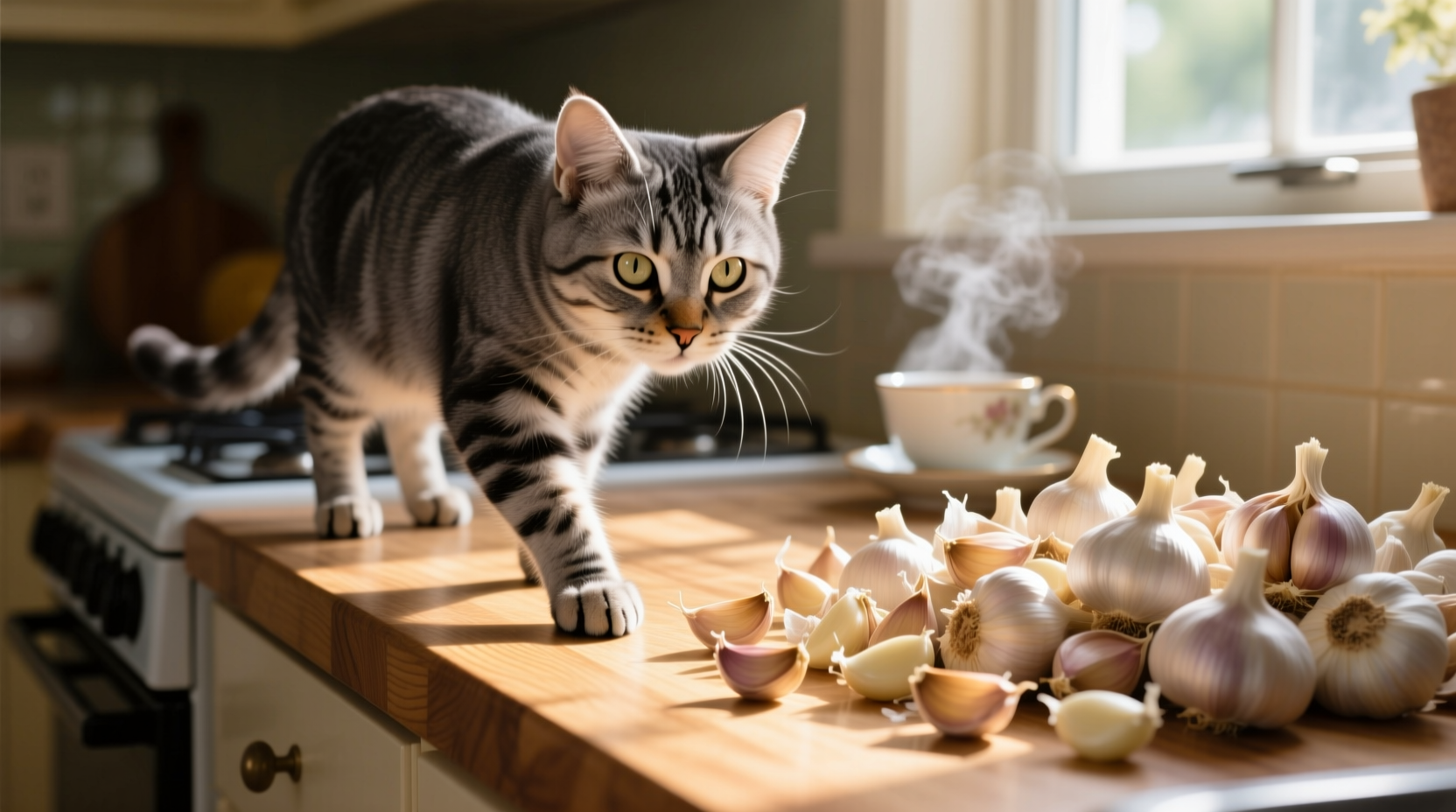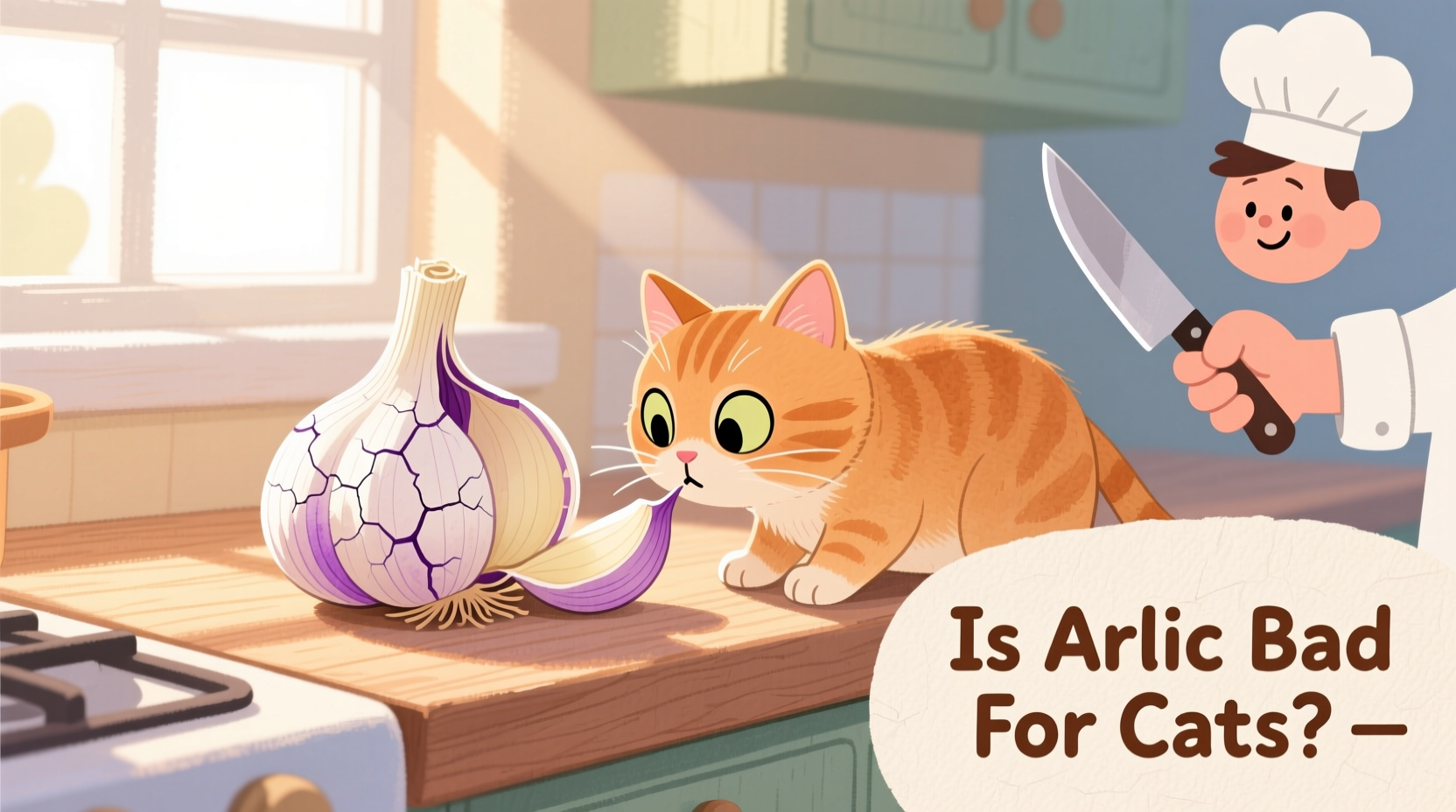Yes, garlic is extremely dangerous for cats. Even small amounts can cause hemolytic anemia, damaging red blood cells and potentially leading to life-threatening complications. This comprehensive guide explains why garlic is toxic to cats, symptoms to watch for, immediate actions to take, and how to prevent accidental exposure.
When your cat accidentally ingests garlic, every minute counts. As a pet owner, understanding the serious risks associated with allium vegetables like garlic could save your feline companion's life. Unlike humans who can safely enjoy garlic in moderation, cats lack the necessary enzymes to metabolize compounds found in garlic, making even seemingly harmless amounts potentially fatal.
Why Garlic Poses a Serious Threat to Feline Health
Garlic contains N-propyl disulfide, a compound that triggers oxidative damage to red blood cells in cats. This process, called hemolysis, causes red blood cells to rupture prematurely, leading to hemolytic anemia. Cats are particularly vulnerable because they have lower levels of the antioxidant enzyme glutathione compared to humans and dogs.
According to research published in the Journal of Feline Medicine and Surgery, garlic is approximately five times more toxic to cats than onions. The toxic principle affects cats regardless of whether the garlic is raw, cooked, powdered, or dehydrated. Many pet owners mistakenly believe that cooked garlic is safer, but the toxic compounds remain active through cooking processes.
Symptom Timeline: What to Watch For After Garlic Exposure
Understanding the progression of garlic toxicity symptoms helps pet owners recognize when emergency veterinary care is needed. Symptoms typically develop gradually over several days:
Danger Levels: How Much Garlic Harms Cats
Many cat owners wonder how much garlic constitutes a dangerous dose. Research from the ASPCA Animal Poison Control Center indicates that toxicity depends on both the amount consumed and the cat's size:
| Garlic Form | Toxic Dose for Cats | Equivalent Human Food |
|---|---|---|
| Raw garlic cloves | 15-30 grams per kg of body weight | Just 1-2 cloves for average cat |
| Garlic powder | 5 grams per kg of body weight | 1/2 teaspoon can be toxic |
| Garlic supplements | Varies by concentration | Often highly concentrated |
| Cooked food with garlic | Depends on garlic content | Even small amounts risky |
It's crucial to understand that no amount of garlic is considered safe for cats. Some cats develop sensitivity after repeated small exposures, while others may show symptoms after a single incident. Kittens, senior cats, and cats with pre-existing health conditions face even greater risks.

Immediate Actions: What to Do If Your Cat Ate Garlic
If you suspect your cat has consumed garlic, follow these critical steps:
- Remove remaining garlic - Clear any accessible garlic sources from your cat's environment
- Contact your veterinarian immediately - Even if no symptoms are present yet
- Do not induce vomiting unless specifically instructed by a veterinary professional
- Bring packaging or sample of the consumed garlic product to the vet
- Monitor closely for early symptoms while traveling to the clinic
Veterinary treatment for garlic toxicity typically includes intravenous fluids, oxygen therapy, and in severe cases, blood transfusions. Early intervention significantly improves recovery chances. According to the Veterinary Information Network, cats treated within 12 hours of ingestion have substantially better outcomes than those receiving delayed care.
Common Misconceptions About Garlic and Cats
Despite widespread veterinary warnings, several dangerous myths persist in pet communities:
- "Small amounts are safe" - No safe threshold exists; cumulative exposure causes damage
- "Cooked garlic loses toxicity" - Heat doesn't eliminate toxic compounds
- "Garlic prevents fleas" - This folk remedy causes more harm than good
- "My cat ate garlic before with no issues" - Delayed symptoms may appear after repeated exposure
A 2023 survey by the American Association of Feline Practitioners revealed that 38% of cat owners incorrectly believe small amounts of garlic are safe for cats, highlighting the urgent need for accurate information dissemination.
Preventing Accidental Garlic Exposure
Protect your cat by implementing these safety measures:
- Store garlic, onions, and related products securely out of reach
- Read pet food and treat labels carefully for garlic derivatives
- Avoid sharing human food containing garlic or onion
- Be cautious with homemade pet food recipes
- Educate all household members about garlic dangers
Remember that garlic powder and garlic salt pose equal risks to fresh garlic. Many commercial baby foods and some pet treats contain garlic as a flavor enhancer, making label reading essential. When preparing meals, keep cats out of the kitchen to prevent accidental ingestion of food scraps.
Safe Flavor Alternatives for Cats
If you're looking to enhance your cat's food flavor safely, consider these veterinarian-approved options:
- Small amounts of cooked, unseasoned chicken or fish broth
- Catnip or valerian root for aromatic interest
- Commercial cat food toppers specifically formulated for felines
- Tiny portions of cooked pumpkin (not pie filling)
Always introduce new foods gradually and in small quantities to monitor for adverse reactions. Consult your veterinarian before making any dietary changes to ensure they're appropriate for your cat's specific health needs.
Frequently Asked Questions About Garlic and Cats
How quickly does garlic affect cats?
Garlic toxicity symptoms typically appear 24-48 hours after ingestion, though gastrointestinal upset may occur within hours. The most dangerous effects on red blood cells develop over several days as oxidative damage accumulates. Immediate veterinary consultation is crucial even if no symptoms are present initially.
Can cats recover from garlic poisoning?
Yes, cats can recover from garlic poisoning with prompt veterinary treatment. Recovery depends on the amount ingested and how quickly treatment begins. Mild cases may resolve with supportive care, while severe cases requiring blood transfusions have longer recovery periods. Most cats fully recover when treated within 12 hours of ingestion.
Is garlic powder more dangerous than fresh garlic for cats?
Garlic powder is actually more concentrated and potentially more dangerous than fresh garlic. Dehydration concentrates the toxic compounds, meaning smaller physical amounts contain higher toxin levels. Approximately 1 teaspoon of garlic powder equals one whole garlic clove in toxicity potential, making accidental overdoses more likely with powdered forms.
What human foods containing garlic should I avoid sharing with my cat?
Avoid sharing any human foods containing garlic including garlic bread, pasta sauces, salad dressings, soups, stews, and processed meats. Be particularly cautious with baby food, which sometimes contains garlic as a flavor enhancer. Even foods cooked in garlic-infused oil pose risks, as the toxic compounds transfer to other ingredients during cooking.
Are kittens more sensitive to garlic than adult cats?
Yes, kittens are significantly more vulnerable to garlic toxicity than adult cats. Their developing organs and smaller body size mean that even tiny amounts of garlic can cause severe damage. Kittens also have less developed detoxification systems, making it harder for their bodies to process and eliminate the toxic compounds. Extra caution is essential in households with both kittens and garlic-containing foods.











 浙公网安备
33010002000092号
浙公网安备
33010002000092号 浙B2-20120091-4
浙B2-20120091-4